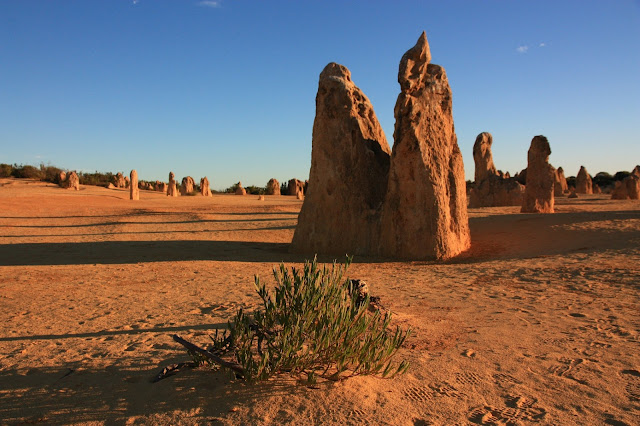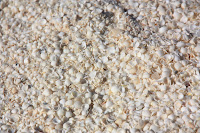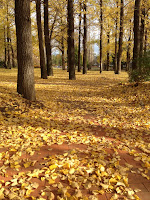 Large migrations are one of the
spectacles of nature. Just picture those TV images of birds swarming in
gracious patterns, of wildebeest thumping over dry savannah, of whales
gathering in bays to feed and flap and soar into the sky as Attenborough calmly
reassures us this is perfectly normal. In Western Australia, a migration of
sorts northwards in June; ageing men in too short shorts and collared polo
shirts hitch up thirty metre caravans to a white Hilux overflowing with fishing
gear. Their partners, replete in grey slacks and pastel tops, with expensive
designer rim glasses perched atop their nose, support the hitching process...left a bit, back, whoa, stop. They might
add a boat to the top of the trailer, and affix the very necessary solar panels
and satellite dish. And then they are on their way, clustering with others for
months and months at prime camping positions up and up the west and north
coast.
Large migrations are one of the
spectacles of nature. Just picture those TV images of birds swarming in
gracious patterns, of wildebeest thumping over dry savannah, of whales
gathering in bays to feed and flap and soar into the sky as Attenborough calmly
reassures us this is perfectly normal. In Western Australia, a migration of
sorts northwards in June; ageing men in too short shorts and collared polo
shirts hitch up thirty metre caravans to a white Hilux overflowing with fishing
gear. Their partners, replete in grey slacks and pastel tops, with expensive
designer rim glasses perched atop their nose, support the hitching process...left a bit, back, whoa, stop. They might
add a boat to the top of the trailer, and affix the very necessary solar panels
and satellite dish. And then they are on their way, clustering with others for
months and months at prime camping positions up and up the west and north
coast.
They are generally amiable, and
interesting to observe. And they are not alone, for other rarer creatures
compete for space, curious to see what all the fuss is about. Backpackers from
Europe, congregating in small clusters of battered vans and crammed cars and
skimpy shorts. Surfers and beach bums sat on the sands plucking a guitar. Nice
couples, often from overseas too, who are all rather nice and goody-goody. And
us, somewhat misplaced and nonconformist, prolonging the opportunity to wear
shorts and listen to Eurotrash music as we head north by northwest.
It doesn’t take long upon leaving
Perth to return to vast open spaces and infrequent settlements. It takes a lot
longer for the weather to warm significantly and the water temperature to be more
suitable however. A few hours north of the city sits Cervantes, and a return to
camping after so much luxury. The attraction here is Nambung National Park and The Pinnacles Desert, which is truly a
spectacle as the end of day light casts shadows and red and orange glows across
the many jagged pillars littering the landscape. What is especially great is
that you can walk among them, without barriers and too many authoritarian
impositions.
From the Pinnacles it was a slow and steady drift up the coast, pausing at towns like Jurien Bay and Dongara and Geraldton, typically for coffee or beer or petrol or food. This was all en-route to Kalbarri, where a few days were well spent both working and sightseeing. Kalbarri is a lovely little spot, akin to some of the coastal towns of New South Wales and Victoria, with a few fine beaches, a snaking estuary and river, daggy looking shops and cafes and motels and pubs. There are fishing people and boat people and backpackers and grey nomads and us. There are seabirds and jetties and sunsets on the sands. It’s quite a treasured little spot.
Kalbarri is situated amongst some
spectacular rugged scenery. Indeed, the coast around Kalbarri is full of
dramatic bluffs and gorges and tumbling red rocks, plummeting down to a
pounding, pristine Indian Ocean. It is ever-changing evidence of the battle
between land and sea, as rock platforms emerge over millions of years and
crumble away as they are gnawed at by the ebbs and flows of water, baked by the
searing summer sun and pounded by winter storms. It is well worth migrating to.
The coastline is protected within
the borders of Kalbarri National Park,
which extends inland following the Murchison River and encompasses an
increasingly rocky and arid landscape of gorges and cliffs. Work on the access
road to the interior of the park meant that access was restricted, and could
only be reached by participation on either an abseiling or canoeing tour.
Gently paddling on still waters through a red rock gorge sounds much more
appealing than jumping off a cliff, so a few hours on the water was as good a
way as any to appreciate the surroundings and experience this special place.
Leaving Kalbarri the next stop on
the migratory route is around Shark Bay,
a World Heritage Area. It seems the name does not put anyone off and curiously
it’s renowned for dolphins more than sharks. It also has living things older
than sharks and dolphins and some of those grey nomads in too short shorts and
Big W polo shirts. Stromatolites at Hamelin
Pool, as memorably featured in a book by Bill Bryson, are the oldest living
organisms on earth. I think they may have helped other life forms develop, by
releasing small bubbles of oxygen into very salty water. As living creatures
go, they are not quite as spectacular to look at as, say, a backpacker in
skimpy shorts. But they are, in their own little way, quite amazing. (By the
way, they are the things that look like rocks on the picture!)
Shells are pretty cool too, and
there are many to see washed up along the bays and shores of this area. Most seem
to occur at the inspirationally-named Shell
Beach. In fact, the whole beach is made up of shells, all perfectly small
and white and crunchy. Millions upon millions fringe the bay and they are quite
mesmerising to lie in, run your hand through, throw in the air and crouch down
in silly positions to get photos of.
Another cool thing around Shark
Bay are dolphins, which generally hang out around Monkey Mia (which has no monkeys...that would be just too cool). An
equally cool thing is the water in which you wade in to look at the dolphins on
a grey, windy June day. It is no tropical paradise yet let me tell you. And as
a park ranger rambles on with some interesting factoids and with each factoid
you lose the feeling further up your legs, the only solace is the dolphin amiably
milling about, probably smugly thinking I’m
quite warm thanks, plus I am soon to eat some tasty fish, while for you, my Homo
sapiens friend, the coffee shop is closed. Those clicky sounds are actually
sniggers of laughter.
The dolphins don’t tend to
migrate from here, but for our human friends the exodus rejoins the Northwest
Coastal Highway and ploughs on into the town of Carnarvon. Here, palm trees and bananas greet you and it should be
almost tropical but it is still a little cool. There is not a great deal to
see, but a decent coffee and some very decent and reasonably priced fish and
chips. It seems to be an enclave for some of those migrating nomads, who linger
long over winter and happily mill about the caravan park in which swags are a
rare curiosity.
Swags are much more at home just
an hour north of Carnarvon around Quobba
Station. This is a more rustic experience with ramshackle aluminium sheds
and rusty gates, dusty earth and scraggly saltbush. It’s in a beautiful place,
where the ocean can explode in fury at one spot and just a little further along
shimmer sedately protected by rocks and reef. Shells and coral litter the
shores, where the water is just that little bit warmer and reaching the okay to
paddle threshold. It’s a bit off the beaten track, off the main road, and I
kind of like it that way.
The northern end of Quobba
Station borders Ningaloo Reef, a
band of coral that extends north now fringing the coast all the way to Exmouth.
Coral Bay is much more on the beaten
track, a point at which road and campsite and fish and boat people meet the
amazing turquoise waters, clear and silky in the shallows and dotted with
darker clumps signifying coral. Huge snapper are happy to drift alongside legs
and feet and snorkels, all in water that is again just that little bit warmer. It
is idyllic in many ways and even the hustle and bustle of migratory visitors
doesn’t afflict it too much. And besides, a bit of civilisation is good, for
ice creams can be bought just a few metres from the water.
You can stay at Coral Bay in a
campsite or two which has aimed to capture that genuine shanty town experience.
They’ll probably charge you handsomely for it, and you can mingle with other
big rigs and people wearing too short shorts. Or, like us, you can spend an
hour to drive north and have a night at a delightful, genuine outback station. Bullara Station wasn’t flash nor
obviously scenic but it was nonetheless full of charm and character. Friendliness
abounds, from the family owners who welcome you to visit their place, to the
characters camping and cooking and sharing damper around a communal fire. It’s
a true blue, red earth kind of place, where you can buy some beef directly from
the farm and have a hot shower in the open air (though thankfully within a
closed corrugated perimeter). It was one of my favourite stops of the trip and
the shower was heaven.
 From the outback to the tropics,
all within 30 minutes or so. Crossing the Tropic
of Capricorn on the road to Exmouth, things weren’t that noticeably warmer
or more tropical. Termite mounds pepper the arid landscape, and ranges rise to
the west. It’s not until you once more glimpse the azure seas near Exmouth that you remember you are now in
a tropical water world. And fleetingly passing through Exmouth for shopping,
petrol and good coffee, you reach the end of the cape, but not the end of the
road.
From the outback to the tropics,
all within 30 minutes or so. Crossing the Tropic
of Capricorn on the road to Exmouth, things weren’t that noticeably warmer
or more tropical. Termite mounds pepper the arid landscape, and ranges rise to
the west. It’s not until you once more glimpse the azure seas near Exmouth that you remember you are now in
a tropical water world. And fleetingly passing through Exmouth for shopping,
petrol and good coffee, you reach the end of the cape, but not the end of the
road.
The western side of this tip of
land is dominated by two very marvellous things – Ningaloo Reef, practically
coming right next to the shore, and the marvellous Cape Range National Park. It
is, as the tourist brochures boast, where the ranges meet the reef. It is
immensely popular with migratory animals, including turtles and whale sharks
and many, many grey nomads and backpackers. Camping in the national park, next
to the reef, is practically off-limits as people who don’t usually bother
staying in national parks decide they will park up and stay in their big rigs
for two months. It seems a little unfair, but thankfully a decent campground
outside the park offered a good base from which to explore.
Cape Range National Park was a delight, in particular the rugged
gorges that cut through the red ridges, an archetypal elemental landscape of
inland and northern Australia. Two walks at two separate gorges – Yardie and
Mandu Mandu – were really enjoyable and offered a fine return to decent
bushwalking. The first followed the only watercourse cutting through the range
and sometimes spilling out into the ocean. Yardie
Creek cut increasingly deeper into the red rocks, offering solace for
snakes and lizards, rock wallabies and emus.
Mandu Mandu Gorge was altogether different, in that it was a dry
creek almost all of the time, the residue of white and pink pebbles offering
something of a track to follow, before clambering up above the creek bed for
superlative views of the snake like gorge system. Beyond, not too far, the
multifaceted blue colours of Ningaloo testament to the sloganeering of the
range meeting the reef.
And what of this reef? A reef
that compels you to take countless photos of clear water, shimmering on the
sandy sea bed as it refracts the sun above, changing in colour to reflect the
sea floor, from golden to white to turquoise to azure. It is, in the right
spots, reasonably warm and embraces many species of coral and fish and crab and
turtle. Turtles that occasionally peer out of the water, checking what is going
on before drifting away like a clump of seaweed. Aptly named Turquoise Bay is
the place to see all this and sit and stare and sleep and sunbathe and revel in
this northward migration.
This is the end of this road, the
northernmost point I would suspect, but I guess you never know. The migration
for others continues to head north and east...Karratha, Port Hedland, the
utopia that is supposedly Broome. Trailers and utes, big rigs and small vans will
continue to bumble their way along. Amongst it all, a blue Subaru Outback with
a chunky roof box will head one way or another, seeking out more red rocks and
dust, outback vistas and dazzling sunsets, making its own course amongst the
many as it veers around and back to Perth.



























